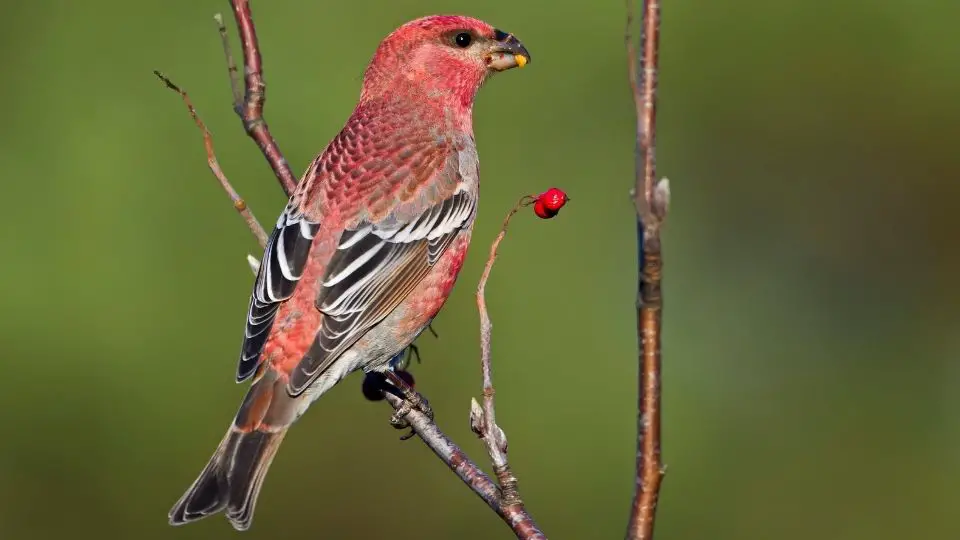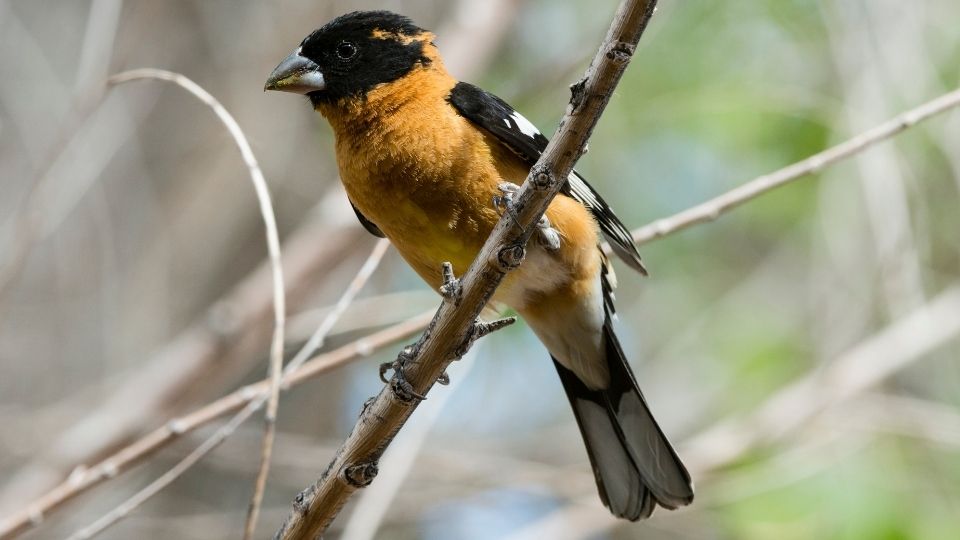View grosbeak images of the seven species found in the US. If you haven't seen any of these songbirds in person, these pictures will help you identify which species of grosbeak are around your area. The most notable features of grosbeak songbirds are their large conical beaks and they are typically yellow and or other colors.
Have you ever noticed an unfamiliar big-billed bird at your bird-feeders? Odds are, it was a grosbeak! To learn about the most common species of this fascinating family of songbirds, keep reading. Grosbeaks are large-billed birds found in most parts of the United States and North America.
While they all share some things in common, most species of grosbeaks do not belong to the same family of birds. From the familiar evening grosbeak to the elusive blue grosbeak, no matter where you are in the United States, there’s a chance you can catch a glimpse of these birds if you look carefully.
What Kind Of Bird is a Grosbeak?
Grosbeaks are unique because they do not belong to just one family of birds. Some grosbeaks are members of the Cardinalidae family, while others are members of the Fringillidae family. The name grosbeak is French and translates to ‘large beak.’ There are seven types of grosbeaks in North America, which include:
- Evening Grosbeak
- Black-headed Grosbeak
- Yellow Grosbeak
- Blue Grosbeak
- Pine Grosbeak
- Crimson-collared Grosbeak
- Rose-breasted Grosbeak
While there are seven types of grosbeaks in North America, some are more common than others. The crimson-collared grosbeak, for instance, is only found in very specific parts of Mexico and is not found in North America. Check out these most common and notable species of grosbeaks below to check them off your birdwatching bucket list!
The Most Notable North American Grosbeaks

Pine Grosbeak
The pine grosbeak, aka Pinicola enucleator, lives in lush pine forests in North America in cooler climates such as Alaska and Canada. If you want to glimpse the pine grosbeaks’ striking red plumage, head for the thick protection of heavy pine trees. While the pine grosbeak males have showy plumage, and the female pine grosbeak has coloring similar to that of a house sparrow.
It has muted brown and gray feathers with just a dusting of cinnamon on its head. While they spend their breeding season far north in cooler climates, they are short-distance migrants that travel to the Great Lakes region in search of available seed sources in the wintertime.

Evening Grosbeak
The evening grosbeak (Coccothraustes vespertinus) numbers have dwindled over the years and are found on the vulnerable species list. Unlike other grosbeaks that belong to the Cardinal family, the evening grosbeak is a member of the Fringillidae family or the family of true finches. While these songbirds are small, like finches, they have slightly larger frames.
Their size is somewhere between a finch and a Northern cardinal. Male evening grosbeaks have bright yellow underparts, distinctive yellow eyebrows, and black wing bars that land them on every birdwatchers bucket list! Female evening grosbeaks have similar coloring with more brown and gray notes, making them look washed-out. These birds live year-round in cooler climates in Alaska and travel south as far as the Dakota and parts of the Rocky Mountains to their wintering grounds.
Black-Headed Grosbeak
The black-headed grosbeak is an apparent member of the Cardinal family. It has a distinctive conical-shaped bill, cinnamon-orange plumage, cardinal-like features, and a love of sunflower seeds (and Monarch butterflies). Male black-headed grosbeaks have striking yellow patches under their wings that light up once they take flight and impressive orange underparts. Much like most grosbeaks, the female pine grosbeak isn’t quite as stunning and boasts muted colors with soft orange coloring on its head.
Unlike arctic breeds of grosbeaks, the black-headed grosbeak prefers warmer climates. It spends the breeding season on the United States West Coast in places as far north as Oregon and travels to Central America and Mexico for wintering grounds.
Rose-Breasted Grosbeak
The rose-breasted grosbeak, aka Pheucticus ludovicianus or red-breasted grosbeak, is found throughout most of North America except anything west of the Rocky Mountains. Male rose-breasted grosbeaks have striking red breasts that stand in stark contrast against black and white patches. Female rose-breasted grosbeaks, on the other hand, do not have red breasts. They have spotted brown and white feathers similar to a sparrow. It spends its breeding season in deciduous forests like New York. As a long-distance migrant, it spends its wintering grounds in tropical climates in Central and South America.
Blue Grosbeak
The blue grosbeak is the rarest of the grosbeaks, and it’s one beautiful bird. While it’s a common bird whose numbers continue to climb over the years, spotting one is rare. Male blue grosbeaks have striking blue plumage, with hints of cinnamon brown on their wing bars, while the female coloring is muted.
During the blue grosbeak breeding season, they spend most of their time in the southern portion of the United States, especially in places like Texas and the Great Plains. Once the grosbeak breeding season is over, they migrate across the Gulf of Mexico to the Caribbean or other Central American locations. Most blue grosbeak sightings happen during migration, which is the best time to find them!
How Can I Attract Grosbeaks?
Not all grosbeaks eat the same food. Some grosbeaks are strict vegetarians (such as the pine grosbeak), while others are natural predators of the Monarch Butterfly. To attract grosbeaks to your backyard, opt for things like suet with mealworms or sunflower seeds. Remember that many grosbeaks are cold-weather-loving short-distance migrants, so keep your bird feeders up year-round.

